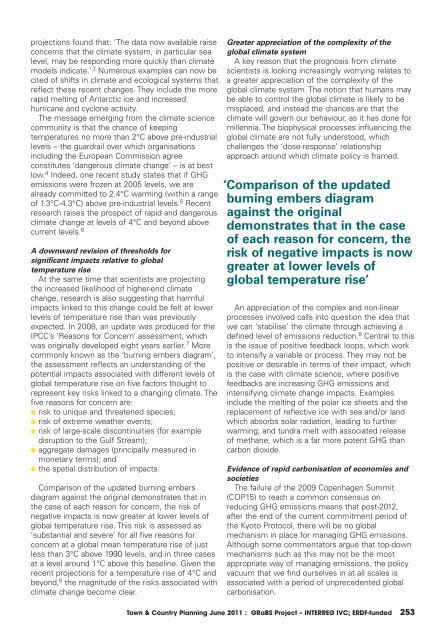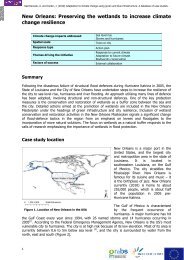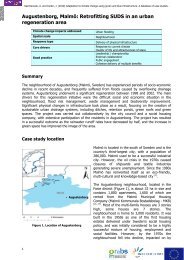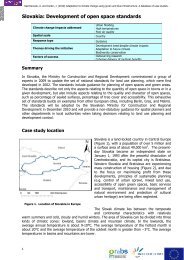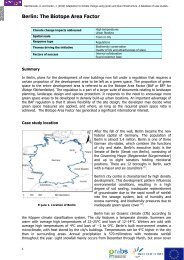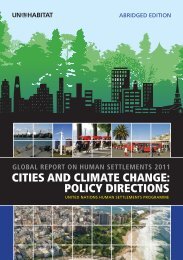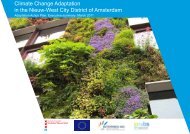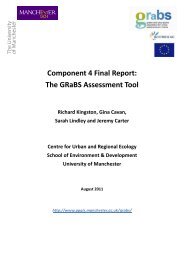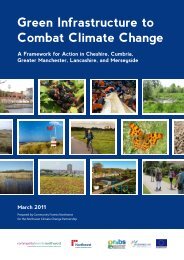Download - GRaBS
Download - GRaBS
Download - GRaBS
Create successful ePaper yourself
Turn your PDF publications into a flip-book with our unique Google optimized e-Paper software.
projections found that: ‘The data now available raise<br />
concerns that the climate system, in particular sea<br />
level, may be responding more quickly than climate<br />
models indicate.’ 3 Numerous examples can now be<br />
cited of shifts in climate and ecological systems that<br />
reflect these recent changes. They include the more<br />
rapid melting of Antarctic ice and increased<br />
hurricane and cyclone activity.<br />
The message emerging from the climate science<br />
community is that the chance of keeping<br />
temperatures no more than 2°C above pre-industrial<br />
levels – the guardrail over which organisations<br />
including the European Commission agree<br />
constitutes ‘dangerous climate change’ – is at best<br />
low. 4 Indeed, one recent study states that if GHG<br />
emissions were frozen at 2005 levels, we are<br />
already committed to 2.4°C warming (within a range<br />
of 1.3°C-4.3°C) above pre-industrial levels. 5 Recent<br />
research raises the prospect of rapid and dangerous<br />
climate change at levels of 4°C and beyond above<br />
current levels. 6<br />
A downward revision of thresholds for<br />
significant impacts relative to global<br />
temperature rise<br />
At the same time that scientists are projecting<br />
the increased likelihood of higher-end climate<br />
change, research is also suggesting that harmful<br />
impacts linked to this change could be felt at lower<br />
levels of temperature rise than was previously<br />
expected. In 2008, an update was produced for the<br />
IPCC’s ‘Reasons for Concern’ assessment, which<br />
was originally developed eight years earlier. 7 More<br />
commonly known as the ‘burning embers diagram’,<br />
the assessment reflects an understanding of the<br />
potential impacts associated with different levels of<br />
global temperature rise on five factors thought to<br />
represent key risks linked to a changing climate. The<br />
five reasons for concern are:<br />
● risk to unique and threatened species;<br />
● risk of extreme weather events;<br />
● risk of large-scale discontinuities (for example<br />
disruption to the Gulf Stream);<br />
● aggregate damages (principally measured in<br />
monetary terms); and<br />
● the spatial distribution of impacts.<br />
Comparison of the updated burning embers<br />
diagram against the original demonstrates that in<br />
the case of each reason for concern, the risk of<br />
negative impacts is now greater at lower levels of<br />
global temperature rise. This risk is assessed as<br />
‘substantial and severe’ for all five reasons for<br />
concern at a global mean temperature rise of just<br />
less than 3°C above 1990 levels, and in three cases<br />
at a level around 1°C above this baseline. Given the<br />
recent projections for a temperature rise of 4°C and<br />
beyond, 6 the magnitude of the risks associated with<br />
climate change become clear.<br />
Greater appreciation of the complexity of the<br />
global climate system<br />
A key reason that the prognosis from climate<br />
scientists is looking increasingly worrying relates to<br />
a greater appreciation of the complexity of the<br />
global climate system. The notion that humans may<br />
be able to control the global climate is likely to be<br />
misplaced, and instead the chances are that the<br />
climate will govern our behaviour, as it has done for<br />
millennia. The biophysical processes influencing the<br />
global climate are not fully understood, which<br />
challenges the ‘dose-response’ relationship<br />
approach around which climate policy is framed.<br />
‘Comparison of the updated<br />
burning embers diagram<br />
against the original<br />
demonstrates that in the case<br />
of each reason for concern, the<br />
risk of negative impacts is now<br />
greater at lower levels of<br />
global temperature rise’<br />
An appreciation of the complex and non-linear<br />
processes involved calls into question the idea that<br />
we can ‘stabilise’ the climate through achieving a<br />
defined level of emissions reduction. 8 Central to this<br />
is the issue of positive feedback loops, which work<br />
to intensify a variable or process. They may not be<br />
positive or desirable in terms of their impact, which<br />
is the case with climate science, where positive<br />
feedbacks are increasing GHG emissions and<br />
intensifying climate change impacts. Examples<br />
include the melting of the polar ice sheets and the<br />
replacement of reflective ice with sea and/or land<br />
which absorbs solar radiation, leading to further<br />
warming; and tundra melt with associated release<br />
of methane, which is a far more potent GHG than<br />
carbon dioxide.<br />
Evidence of rapid carbonisation of economies and<br />
societies<br />
The failure of the 2009 Copenhagen Summit<br />
(COP15) to reach a common consensus on<br />
reducing GHG emissions means that post-2012,<br />
after the end of the current commitment period of<br />
the Kyoto Protocol, there will be no global<br />
mechanism in place for managing GHG emissions.<br />
Although some commentators argue that top-down<br />
mechanisms such as this may not be the most<br />
appropriate way of managing emissions, the policy<br />
vacuum that we find ourselves in at all scales is<br />
associated with a period of unprecedented global<br />
carbonisation.<br />
Town & Country Planning June 2011 : <strong>GRaBS</strong> Project – INTERREG IVC; ERDF-funded 253


